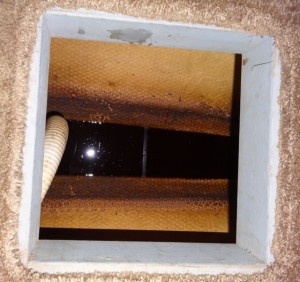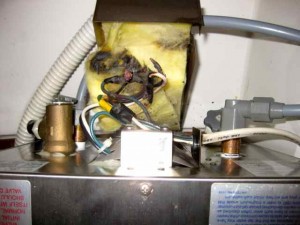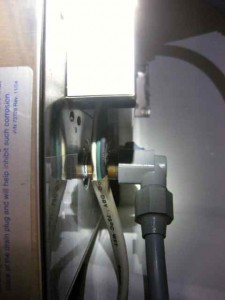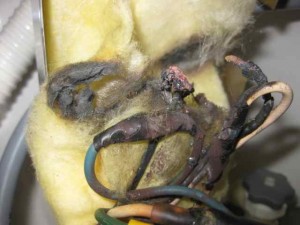I inspected a boat a few days ago and noticed that there was oil in the forward cabin bilge area. Quite a surprise and a good find so I turned off the forward bilge pump automatic float switch and went to work to determine where the leak was coming from.
Using a paper towel, I dipped it into the bilge, removed it and inspected the towel – the oil was for the most part, clean but mixed with a little bit of old engine oil.
Was the oil changed recently and someone was just sloppy and not cleaned up? Well, I had to find out what was going on.
A mechanic was in the engine room inspecting and testing the engines and told me that he also saw an oil leak under the port engine. I asked him if the oil was clean or dirty – he said “dirty, how could it be clean?”
So now we have the ingredients of a mystery, this will be interesting I thought to myself. So I went back to the forward bilge and lo and behold, the level of oil and water in the bilge had risen.
OK, back to the mechanic asking him how much was leaking, “Just a little”. Alright, this is getting interesting – the engine is leaking when it is operating and oil is accumulating in the forward bilge – more clean oil than dirty.
The buyer is now worried, the mechanic is saying that the engine may need to be removed from the engine room to repair. The selling broker and the seller’s representative are worried and I want to figure out what’s going on. Mechanic takes oil samples and leaves.
I check the engine oil levels – they are OK, a little low but no medium or large leak happening. Conversations about buying or not buying the boat are starting. Fear, uncertainty and doubt are raising their heads with the buyer.
I get into the engine room and notice that when more than two people are on the port side of the boat, clean oil is leaking from the outside (outboard) stringer and running slowly into the bilge. So it didn’t have anything to do with the engine operating or not. Strange, maybe there was an container leaking somewhere aft so I inspect the aft port engine room and sure enough six, one gallon oil containers were stored and stacked up on one another. One of the bottom containers was cracked and leaking from its moving around when the boat was underway.
So the leak was found and spilled oil cleaned up. Case closed, now I could get onto the rest of the boat which is another subject I’ll write on. Plenty of electrical issues.
So, whatever you do, don’t store containers of oil (or anything else for that matter) in your bilge unless it is secured from any movement and have some kind of chafe and / or cushioning protection around and under them like absorbent pads or similar.
Pumping oil overboard (intentionally or unintentionally) is a state and federal offense that carries big fines and is terrible for the environment. Keep oil absorbent pads in your bilges.
Speaking of the oil pads, I was on a boat last week that had so many oil pads that they actually covered the bilge pump float switches. So there was no way that the bilge pump float switch could operate. And, the bilge was full of water up to the cabin sole – scary stuff. Owner was surprised as I was. He had an oil leak and instead of getting it fixed, he kept on throwing oil pads down into the bilge. Interesting.
Take a look in your bilges every time you’re aboard – you may find an oil leak, debris, high water, lost pen, wrenches, gold doubloons, or who knows what else. Keep the bilges clean and clear.
While you’re at it, install high water bilge alarms – they could save your boat.
Water Heater – Heat/Smoke/Fire
Last week I had the unfortunate experience of almost getting electrocuted. Really scary stuff!
I was inspecting a boat for a client and I turned on the water heater that was reported as newly installed. A few minutes after that, I started checking the AC electrical wiring for polarity and found that there was no ground wire connection in the boat. So I turned off the main circuit breaker for the AC system.
OK I thought, I’ll take a look at the water heater. But what I found or should I say smelled was a surprise.
When I removed the settee cushion and hatch over the heater a huge puff of acrid smoke and odor hit me hard. Electrical Fire! I immediately pulled back and found a fire extinguisher and went back to the water heater. The fire was out and there was just smoke now and that was clearing up but it had me coughing and the odor and smoke forced me out of the boat. I disconnected the shore power cord and brought it into the boat and hid it below the v-berth so no one would be a good neighbor on the dock and plug in the cord if it was on the dock disconnected. I also disconnected the water heater circuit breaker wiring and put a note on the main panel stating the danger.
The smoke and odor cleared and I went back in to see what the heck happened. It was obvious that whoever installed this new water heater didn’t know what they were doing and could of caused a large fire and / or killed someone. Knowing that I was safe, I leaned over, kneeling on the settee with one hand on the settee and the other on the water heater case. I opened the metal cover over the wire connections and was faced with several the problems.
- The wires entering the water heater were not chafe or strain protected. In fact, they were lying directly against the brass plumbing and the water heater metal case.
- The wires that were laying on the case had bare wires that were either chafed or damaged when they were installed and the bare wires were shorting on the case. This effectively electrified the water heater case!
- The wires tucked inside the heater that were attached to the manufacturer pig-tail wires were not connected well.
And that’s about the time that it hit me. Had I kneeled over and touched the water heater case when it was connected to the electrical system I may have been electrocuted. I would have touched the metal water heater case that had electricity on it. The electricity would have attempted to find ground through me because there was no ground connected within the boat or shore power system – I would have been the ground wire!
Needless to say the experience was very sobering to me. I should have used my non-contact AC detector to touch the water heater case first to see if it was safe but I didn’t. I used to use my voltage detector on AC devices all of the time but I guess I was bit cavalier this time and I learned a lesson. Since then, I am back to carrying my detector in my shirt pocket and have gone back to my habit of testing everything AC first.
It’s so easy to use the detector, all you do is touch it to the case or device you want to test, on my detector if the light glows, there’s electricity and it’s not safe to touch.
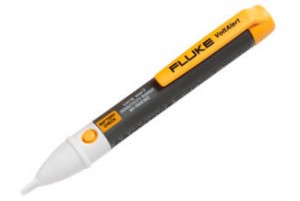 Do yourself a favor and get and use a non-contact AC electrical voltage detector. I have a Fluke detector and I like it because it detects low and high levels of AC electricity and it’s high quality. If you’re going to buy one, you should expect to pay $25-50. for a good detector. Probably don’t need to say it but that’s a low price to save your life!
Do yourself a favor and get and use a non-contact AC electrical voltage detector. I have a Fluke detector and I like it because it detects low and high levels of AC electricity and it’s high quality. If you’re going to buy one, you should expect to pay $25-50. for a good detector. Probably don’t need to say it but that’s a low price to save your life!
Check Your Bilge Pumps
When I’m inspecting the bilge of a boat I naturally test bilge pumps, both electrically and manually operated and I often find problems.
Here are the top problems I find with electric bilge pumps:
- Incorrect over current protection (fuses / circuit breakers).
- No over current protection.
- Pumps not secured – laying on their sides, upside down.
- Automatic float switches inoperable – broken, obscured, water intrusion.
- Corroded electrical wiring and connections.
- Incorrect type hoses.
- Pumps not sized properly to the boat – too small.
- Check valves installed – can cause clogs, don’t use them on primary pumps.
- Installed without vented loops.
- Hose runs too long.
Here are the top problems I find with manual bilge pumps:
- Cracked, dry-rotted rubber diaphragms.
- Incorrect type hoses.
- Lack of strainers on the bilge end of hose.
- Hose runs too long.
- Bilge pump handle missing.
- Check valves installed – can cause clogs, don’t use them on primary pumps.
- Installed without vented loops.
In the case of electric bilge pumps, the number one problem I come across is the wrong size fuse for the pump. It’s pretty common especially if you didn’t install the pump your self and / or don’t have the original manual. I’d estimate that 60% of the bilge pump fuses I check are not correctly sized. Fuse sizes are marked on the bilge pump body and a quick check with a flashlight and mirror you should see the recommended fuse size. Once you have the correct fuse size you should go to the bilge pump fuse and see if the size matches up. If it doesn’t match up, install the correct size fuse. If there is no fuse, maybe the pump is connected to a circuit breaker on an electrical panel – if it is, the breaker is most likely over sized. No worries, just install an inline fuse holder and the correct fuse. OK, what if there is no fuse or circuit breaker? Install one right now.
So what’s the big deal about bilge pump fuse size? Well, if the bilge pump electric motor gets jammed or stuck, its rotor (part that rotates) locks and if it locks, it continues to draw more and more electrical current – think hot. Without the proper size fuse, there is nothing to stop the electricity flowing to the pump and wiring and pumps can melt or catch fire.
The question I get from many boat owners is “how or why would the pump get jammed or locked”. Some (hopefully not yours) bilges are full of all types of nasty stuff like dirt, plastic wire ties, string, fishing line, screws, and construction debris like sawdust, etc. Any of these items could cause bilge pumps to jam.
Regularly inspect and clean your bilges.
Zincs
You may have heard that zincs should be replaced when they are 50% depleted. In most cases this not correct. As the surface area of the zinc anode is reduced, its effectiveness is reduced exponentially. In addition, the attachment of the zinc to the metal that it is supposed to be protecting has been greatly reduced which means that the contact surface between the zinc and metal is not good. For the zinc to properly protect the metal, continuity (connection) must be 100%.
So when your dive service report shows zincs at anything less than 30% it’s time for the zinc to be replaced. It’s also a good practice to ask the dive service to leave the old, wasted zincs on your boat so you can take a look at them. What your looking for is the size and shape of the zincs. Again, if the zinc looks about 20-30% of its original size and smooth but worn, that’s a good sign – probably no corrosion issues. But if they are uneven, pot marked and rough, there is a problem – rough and uneven surfaces indicate electrical corrosion and your sign to get the boat checked for corrosion issues.
Lately I’ve seen two extreme conditions with respect to zinc replacement. In at least 40% of the boats that I inspect that are hauled out of the water for inspection, zincs are either nearly depleted that were reported within days of haul out as good to excellent. The other is dive report within days stating zinc replacement when it was obvious that the zincs are very old and depleted. Either way, its a bad situation. In the first case of reporting a zinc to be good to excellent the diver is really doing his client a dis-service. I have been told by some divers that they are trying to economize zinc replacements for their clients so that they ‘save’ money – Obliviously false economy and can cost a lot of $$$ if a propeller, trim tab, rudder or anything else needs replacement. Zincs are cheap relative to the metals they protect. In the second case it is flat out fraud but some dive services get away with it because who can / does check?

